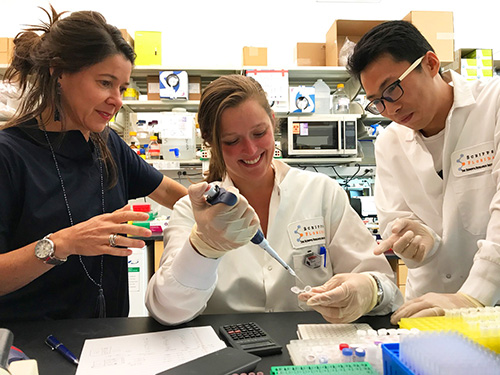Novel Compound Suppresses HIV, Delays Viral Rebound
Scientists from the Florida campus of The Scripps Research Institute have identified a novel drug therapy that suppresses replication of HIV and delays viral rebound.
The “block-and-lock” strategy combines a natural compound called didehydro-Cortistatin A (dCA) with the standard cocktail of antiretrovirals to “block” reactivation of HIV and “lock” the virus into a dormant state. dCA blocks the “engine for HIV replication,” known as Tat, preventing reactivation of the latent reservoir, the primary barrier to a cure.

The authors of the study (left to right): Drs. Susana Valente, Cari F. Kessing, and Chuan Li
Courtesy of The Scripps Research Institute
"No other antiretroviral used in the clinic today is able to completely suppress viral production in infected cells in vivo (in an organism)," said study leader Dr. Susana Valente. “Combining dCA with antiretroviral therapy accelerates HIV-1 suppression and prevents viral rebound after treatment interruption.”
Valente and her colleagues tested the therapy in mouse models with HIV. Once the combined treatment was stopped, viral rebound was delayed up to 19 days, compared to seven days in the mouse models that received only the antiretroviral treatment.
The study used the maximum tolerable dose of the drug with no side effects. The animals were exposed to treatment for one month.
“That’s a relatively short period of time,” Valente said. “We think longer treatments will result in longer, or even permanent, rebound delays. The question is how long? We’re studying that now.”
Valente told the Miami Herald she is encouraged by the findings, but several questions remain, including the long-term effects of the therapy and whether immune competence (the body’s ability to produce a normal immune response) can be restored.
She said the next step is to test the therapy in monkeys.
“The idea here is if we understand this very carefully, we might be able to move to a single drug or a drug that doesn’t have to be taken that often,” she said.
The study was published October 17 in the journal Cell Reports.
See also: New Research Opens the Door to ‘Functional Cure’ for HIV